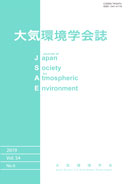
- Issue 6 Pages 195-
- Issue 5 Pages 185-
- Issue 4 Pages 139-
- Issue 3 Pages 85-
- Issue 2 Pages 35-
- Issue 1 Pages 1-
- |<
- <
- 1
- >
- >|
-
Tomoki Mukai, Jun Matsumoto, Masaya Matsuoka, Yasuhiro Sadanaga2019Volume 54Issue 6 Pages 195-201
Published: November 10, 2019
Released on J-STAGE: November 10, 2019
JOURNAL FREE ACCESSWe developed a continuous measurement system of particulate organic nitrates (PONs) based on thermal dissociation followed by a cavity attenuated phase shift spectroscopy (TD-CAPS) technique. The PONs and BG lines were set in this system. For the PONs line, ambient air is introduced into an activated carbon denuder to remove the ambient O3, NO2 and gaseous organic nitrates. The air from the denuder is introduced into a heated quartz tube at 360℃ for thermal decomposition of the PONs to NO2, then the NO2 concentration is measured using a CAPS technique. For the BG line, ambient air is passed through a filter to remove particles including PONs before being introduced into the activated carbon denuder. The Concentrations of PONs are obtained by subtracting the NO2 concentrations measured by the BG line from those by the PONs line. An activated carbon fiber sheet is used in the activated carbon denuder. Characterization of the activated carbon denuder was performed and the optimized denuder has a breakthrough time of more than a half year and a transmission efficiency of more than 90% for PONs. Continuous observations of PONs were made using the TD-CAPS instrument at Osaka Prefecture University. This result demonstrates the performance of this instrument for PONs measurements.
View full abstractDownload PDF (942K) -
Hayato Ishiwari2019Volume 54Issue 6 Pages 202-213
Published: November 10, 2019
Released on J-STAGE: November 10, 2019
JOURNAL FREE ACCESSOrganic compounds that are included in the PM2.5 collected in the mountain and urban areas of Kanagawa Prefecture were analyzed by GC-MS for identification and quantification. As a result, some compounds were confirmed that is have not been previously reported in PM2.5. Both the mountain and urban samples contained pinonaldehyde that is the main oxidative product of α-pinene emitted from softwood. A number of artificial organic compounds, such as butyl carbitol, were detected in the urban samples. ε-Caprolactam that is a raw material of nylon 6 only found in the mountain samples. Perhaps ε-caprolactam found in the mountain samples would be transferred from emission sources. The organic compounds composition in PM2.5 is different in each areas. Therefore, identification of organic compounds that are included in the PM2.5 may lead to determining the source for PM2.5. Incidentally, organic compounds in PM2.5 tended to decrease in concentration in the spring and summer and increase in concentration in the autumn and winter. Additionally, some compounds contained in the PM2.5 identified this time were developed as alternative substances. Furthermore, these compounds are currently being considered for setting the indoor concentration guideline values in Japan. It was suggested that the composition and concentration of the organic compounds contained in the PM2.5 may change with time, indicating the need for continuous monitoring in the future.
View full abstractDownload PDF (1757K)
-
Susumu Sato2019Volume 54Issue 6 Pages A115-A122
Published: November 10, 2019
Released on J-STAGE: November 10, 2019
JOURNAL RESTRICTED ACCESSDownload PDF (2604K) -
Naohide Shinohara, Jun Kohzaki2019Volume 54Issue 6 Pages A123-A129
Published: November 10, 2019
Released on J-STAGE: November 10, 2019
JOURNAL RESTRICTED ACCESSDownload PDF (844K)
- |<
- <
- 1
- >
- >|